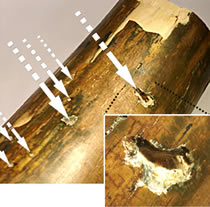
Embedded iron particles surrounded by carbonized rings in the outer layer of a mammoth tusk from Alaska. Inset photo shows how an object ripped through the tusk. Image courtesy Richard Firestone.
Posted on 01/09/2015 4:49:31 AM PST by SunkenCiv
Rock soil droplets formed by heating most likely came from Stone Age house fires and not from a disastrous cosmic impact 12,900 years ago, according to new research from the University of California, Davis. The study, of soil from Syria, is the latest to discredit the controversial theory that a cosmic impact triggered the Younger Dryas cold period.
The Younger Dryas lasted a thousand years and coincided with the extinction of mammoths and other great beasts and the disappearance of the Paleo-Indian Clovis people. In the 1980s, some researchers put forward the idea that the cool period, which fell between two major glaciations, began when a comet or meteorite struck North America.
In the new study, published online in the Journal of Archaeological Science, scientists analyzed siliceous scoria droplets -- porous granules associated with melting -- from four sites in northern Syria dating back 10,000 to 13,000 years ago. They compared them to similar scoria droplets previously suggested to be the result of a cosmic impact at the onset of the Younger Dryas.
"For the Syria side, the impact theory is out," said lead author Peter Thy, a project scientist in the UC Davis Department of Earth and Planetary Sciences. "There's no way that can be done." ...
So if not resulting from a cosmic impact, where did the scoria droplets come from? House fires. The study area of Syria was associated with early agricultural settlements along the Euphrates River. Most of the locations include mud-brick structures, some of which show signs of intense fire and melting. The study concludes that the scoria formed when fires ripped through buildings made of a mix of local soil and straw.
(Excerpt) Read more at phys.org ...
Something happened 12,000 years ago which caused a sharp cooling of climate for a 1000 years. Contemporaneously, in the northern hemisphere most of the megafauna died off—including whoever made the clovis points. We call this period the younger dryas. Why did the sharp counter trend in temperature occur? Did this result in a cascade of events that caused the megafauna to die? Mere cold would not have done it—since the megafauna had experienced many 1000’s of years of cold before without going extinct.
Currently there are a lot of theories as to why this happened. The most popular are human hunters killing the megafauna and the comet strike or some combination of the two. All of them sound plausible. None are proved.
Actually, the impact a few years ago in Russia left no crater, because the object detonated before it could strike the surface.
But the Clovis object hit the icecap. It’s all in the book above.
Global warming and a lack of socialized medicine conspired to cause it. /s
There’s a place for all of God’s creatures, somewhere between the mashed potatoes and the biscuits.
You owe me a new keyboard.

Embedded iron particles surrounded by carbonized rings in the outer layer of a mammoth tusk from Alaska. Inset photo shows how an object ripped through the tusk. Image courtesy Richard Firestone.
Fred, I had the same thing in mind as I reviewed the article.
https://www.mail-archive.com/meteorite-
Abstract:
“We have discovered what appear to be micrometeorites imbedded in seven Alaskan Mammoth tusks and a Siberian bison skull.The micrometeorites apparently shattered on impact leaving 2-5 mm hemispherical debris patterns
surrounded by carbonized rings. Multiple impacts are observed on only one side of the tusks and skull consistent with the micrometeorites having come from a single direction.The impact sites are strongly magnetic indicating significant iron content.”
(Snip)
“The bison skull shows evidence of new bone growth over
the micrometeorite impact sites indicating the animal survived the bombardment and is dated at ~26 ka which is younger than the tusks. This age is consistent with exposure of the bison to an enriched source of radiocarbon following the impact.”
“It appears likely that the impacts, cosmogenic isotope increases,magnetic excursion, and population declines are related events(Occam’s razor), although their precise nature remains to be determined.”
a K. Hughen, et al.,
Science 303, 202-207 (2004).
b L.R. McHargue, P.E. Damon, & D.J. Donahue,
Geophys. Res. Lett. 22, 659-662 (1995).
c J.E.T. Channell,
Earth Planet. Sci. Lett. 244, 379-393 (2006).
d I. Barnes, et al,
Current Biology 17, 1-4 (2007).
The study concludes that the scoria formed when fires ripped through buildings made of a mix of local soil and straw.
Spontaneous combustion, was it? I simply burst out laughing, and then I remembered the mammoth.
Thanks! A comet impact that blasts away atmosphere and exposes the surface of the earth to outer space and extremely cold temperatures might explain findings of frozen wooly mammoths with flowers in their mouths in Siberia. (Must be true! read it on the internet!) Will have to look for info on that later.
The question is, how given anything like the standard version of Earth history, did vast herds of such large creaturesever find food when the entire territory is covered by ice ten months of the year? Elephants are gluttonous; they spend most of their wakinghours eating, in fact, McGowan has stated that he does not understand how anythingever ate enough to get bigger than elephants since there would not appear to be time inthe day for it.
Disclaimer: Opinions posted on Free Republic are those of the individual posters and do not necessarily represent the opinion of Free Republic or its management. All materials posted herein are protected by copyright law and the exemption for fair use of copyrighted works.